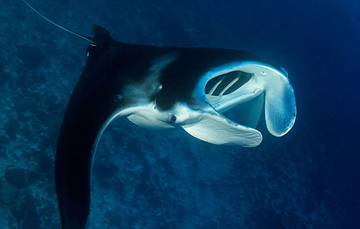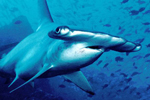
The scalloped hammerhead shark is one of five sharks and two manta rays that won protection today at CITES, so long as it isn’t overturned. Photo by: Stacy Jupiter/WCS.
Today, for the first time, sharks and rays have won the vote for better protection under CITES (the Convention on International Trade in Endangered Species), the world’s regulating body on trade in threatened species. Five shark species and manta rays, which includes two species, have received enough votes to be listed under Appendix II of CITES, which means tougher regulations, but not an outright ban. However, the votes could still be overturned before the end of the meeting.
“Today’s outcome could be a turning point in how CITES can assist in the regulation of trade in marine species,” said Glenn Sant, Marine Program leader with the NGO, TRAFFIC. “If accepted in plenary, this meeting will go down in history as the one where CITES finally realized its marine potential.”
Conservationists have spent nearly two decades trying to get sharks listed under CITES. The world’s sharks have been decimated by the largely unregulated trade in sharks fins for the Chinese delicacy, shark-fin soup. A recent study estimated that 100 million sharks are being killed annually. Many populations have dropped by over 90 percent in the last few decades alone. Manta rays, like sharks, are also being overharvested: the rays are killed largely for their gill plates, which are used in Traditional Chinese Medicine even though the use of gill plates is relatively recent. Both sharks and manta rays reproduce and mature slowly, making it difficult for the species to recover from industrial fishing.
 Manta rays reproduce slowly: only a single pup every 2-5 years, placing them at high risk of over-exploitation. Photo by: © Cat Holloway/WWF-Canon. |
Today’s vote extends protections for the scalloped hammerhead shark (Sphyrna lewini), great hammerhead shark (Sphyrna mokarran), smooth hammerhead shark (Sphyrna zygaena), Oceanic whitetip shark (Carcharhinus longimanus), porbeagle shark (Lamna nasus), the giant manta ray (Manta birostris), and the reef manta ray (Manta alfredi).
“It’s a bittersweet day for sharks,” added Sant. “While their adoption on CITES is warmly welcomed, it’s a sad indictment that their populations have fallen to such a low level that such measures have become a necessity.”
Still, the final meeting—the plenary—could dash conservationists’ hopes. At the last CITES meeting, in 2010, the porbeagle shark won protection only to be stripped of it at the plenary. Opposition to listing sharks, manta rays, and other marine species has largely come from Asian nations, especially Japan and China. They argue that fishing regulations are better handled by regional management groups, however much of the oceans—such as the high seas—receive little management and less enforcement as massive industrial fisheries scoop up wildlife with impunity. In other parts of the world, regulations have been too weak to stop many marine species from becoming endangered.
“This is a landmark moment showing that the world’s governments support sustainable fisheries and are concerned about the reckless over-exploitation of sharks for commercial use,” Carlos Drews, head of WWF’s delegation at CITES. “Today’s decision will go a long way in slowing down the frenzied overfishing of sharks that is pushing them to the brink of collapse to feed the luxury goods market.”

Five species of sharks traded for their meat and fins have been listed in CITES Photo by: M. Burgener/TRAFFIC.
Related articles
Has shark fin consumption peaked at 100M dead sharks per year?

(03/05/2013) While a new study warns that up to 100M sharks are killed annually, there are signs out of China that demand for shark fin may be on the decline. A study published last week in the journal Marine Policy estimated shark deaths at 100 million in 2000 and 97 million in 2010, suggesting a slight drop in shark killing. Meanwhile reports out of China in recent months suggest an accelerating decline in shark fin consumption. China is the top market for shark fin, which is consumed as a status symbol, typically at wedding ceremonies and business dinners.
Saving manta rays from the fin trade

(01/15/2013) Tens of millions of sharks and rays are killed each year to meet demand for shark fin, a delicacy across East Asia. But while the plight of sharks has gained prominence in international environmental circles in recent years, the decline in rays has received considerably less attention. A new film, Manta Ray of Hope, aims to change that. Produced by cinematographer, scuba diver, and marine conservationist Shawn Heinrichs, Manta Ray of Hope offers a look at the mysterious and magnificent world of the world’s largest ray, the manta ray. The film highlights both the threats mantas face as well as some of the people who are working to save them.

(12/04/2012) Sharks are among the most feared of all the world’s predators, yet humans kill tens of millions of sharks for every person who falls victim to shark attack. Part of our fear stems from lack of understanding. A new eBook however tries to change that. Jeff Corwin, an Emmy Award Winning TV host, has this week released Jeff’s Explorer Series: SHARKS, the first of a new eBook series, which Corwin likens to the 21st century version of an encyclopedia. The eBook is rich with video, images, and text. It is narrated by Corwin.
Genetic analysis reveals 79 new species of sharks and rays, many likely endangered
(06/27/2012) Analyzing the DNA sequences of 4,383 specimens of sharks and rays, researchers have discovered 79 potentially new species, raising both the known diversity of this predacious family and concerns that many species are likely more imperiled than thought. Already 32 percent of open ocean sharks and rays are considered threatened with extinction by the IUCN Red List, due largely to overfishing, finning, bycatch, and prey depletion.
Manta rays tracked by satellite
(05/11/2012) Satellite tracking technology has revealed new insights into the behavior of manta rays, reports the Wildlife Conservation Society (WCS). The findings are published in this week’s issue of the journal PLoS.
Camera traps go under the ocean, seeking sharks
(03/12/2012) Remote camera traps, which have become a hugely important conservation tool on land during the past decade, have now gone underwater. Marine biologists have used underwater video camera traps to compare the population of Caribbean reef sharks (Carcharhinus perezii) in Belize’s protected areas versus fishing areas in a new study in the open-access journal PLoS ONE. Conducted from 2005-2010, the study found that reef sharks benefited significantly from conservation areas.